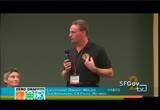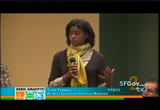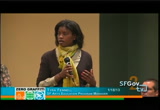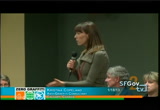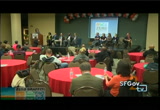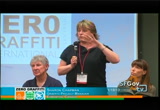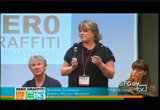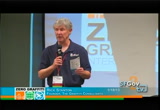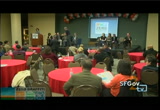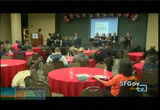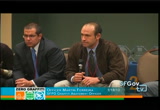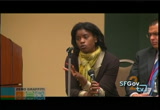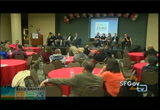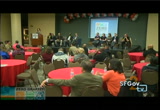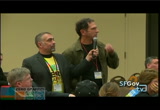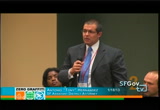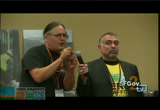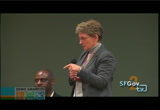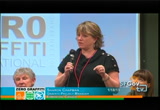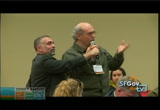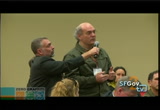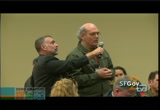tv [untitled] February 24, 2013 3:30pm-4:00pm PST
3:30 pm
this is like a civic administrator or urban planner. you want to control the image making that's going on in your city because it's about your city, right? so, it's a very important part of the program. >> interesting. anybody else? >> i totally agree with that. [speaker not understood] for years actually. >> the mic, have you stand up and you go next and we'll have you go. >> i totally agree with that. a lot of cities are very successful in california with having a mural ordinance or we have house of color for various parts of our city. my city unfortunately chose not to enact that. so, with the fact there are no ordinances against it, fall completely out of the purview of the police code enforcement to deal with it. and that's kind of what i was trying to get across when we were talking about permission if it doesn't violate a local ordinance or state ordinance or any other, you know, legal piece, then we don't have any
3:31 pm
purview to deal with it. so, yeah, that is certainly a great tool to have. every time i bring it up to my city, by the time we get the city attorney involved, arts board involved, everybody else involved, they decide it's too much work to do that and we'll just see what happens. >> one more. let's hear from the san francisco arts commission. >> her statement frightens me. i'm an arts person. this is san francisco, we're in a unique situation in that we really do -- our whole city lich on creativity. and we like to encourage it and also manage it at the same time. the street smarts program that i manage which is funded by dpw is a public/private partnership. all public mural art or any sort of public art has to be funneled through our commission and we have to give permission to do that. but when you're dealing with a private property owner it's slightly different because they basically have -- they have
3:32 pm
ownership of their property and ownership of what goes on that property. but at the same time, if they do put something up like a sunflower or what have you and the neighborhood is against it, how do you manage that? because technically it's their right to put that up. so, in our program, because we did have an incident where there was a complaint from a neighbor, we have encouraged the property boehner to take the rendering from the artist and share it with their neighborhood association and allow two weeks from any feedback. that being said, because it is private property, we can only encourage. so, we're still kind of working on that sort of nuance piece. but i think going to the extreme of making everything a process like public art would be really challenging in an environment like san francisco. so, i think every city is different. san francisco would be drastically affected if we adopted something that stringent.
3:33 pm
>> i just wanted to speak to -- a little bit to [speaker not understood] speaking about the vancouver program. and i do have some experience with that. ways also a coordinator of murals. and one of the benefits of having a process, whether that's a permit, whether there's a fee attached to that, whether there's a committee or if it simply goes through a process where different departments of the city can have input. for example, in vancouver and really the vancouver graffiti management mural program is almost identical to what tyra is talking about doing here. it's similar to public art murals, but similar in scope. when we were doing our murals, almost 200 of them, there was no permit in place, but there was a selection process. and, so, if that was the heritage property, that had to go to heritage. and they had to decide whether or not that building had been painted and if a mural would go there. if so, did it work with the heritage esthetics, et cetera, et cetera. it also goes to the community group or the business group in that area.
3:34 pm
it goes through the graffiti department primarily because we do engage past graffiti vandals who are now legal and are doing artwork. so, in vancouver there is no active graffiti tag names, crew name used in our murals. we've come up with a fairly loose guideline which is being defined by a new graffiti programmer, program coordinator david over there. and they're coming up with some parameters so that the city can work with people that come from graffiti so that there is still some incentive for them to become artistic, to go into doing murals and other art. use their style, use that medium that they enjoy. but if they were to use active graffiti tax or names, we know from our experience of having 200 murals in vancouver it's going to attract graffiti. it's very likely going to have a negative effect on the artwork itself. so, we are building parameters around that and trying to work with the subculture, trying to work with those artists, but
3:35 pm
also understand graffiti is graffiti. our by law in vancouver states that even if you give an artist permission to put up graffiti on your wall, it has to go. they don't permit graffiti on your walls. whether that's in a mural or whether that's just a tag on your wall. so, even if it is done with permission, with consent, if somebody complains or if one of our by law officers come by, it has to go. and it's one of those very clear definitions of graffiti versus art and that's how vancouver has been doing it. i hope that helps a little bit. >> thank you. yeah, i think here in san francisco the difference between graffiti and art is the permission. i hope i appreciate our anonymously written questions. [laughter] >> all right. anybody else have an answer to that one? so, we'll move on to the next one. i'll take somebody from the audience and come back here. good, i'm seeing some hands go up. we'll go with you, if you want to stand up.
3:36 pm
>> my question is about liabilities. if you're doing something that the original tagger, the vandal, let's say, did, and now you're using volunteers to paint it out, what -- has anybody considered the possibility if you don't have police accompaniment to the rehabilitation of that wall, that it's very possible that the person that tagged it is not going to want to see it painted out and might behave in an adversarial situation, perhaps danger? inclusive of the fact that on the other side of the coin is let's say you've got volunteers, you've got kids that work in on the wall. and a possibility of this hazardous material affecting them in some negative way so that later on down the road, those people who were doing a
3:37 pm
volunteer wonderful job are now going to be bringing you into court and saying, you organized this thing and you caused this cancer or whatever it might be. >> great question. and we look like we have a couple of people that would like to take an answer on that one. >> when we do our graffiti wipe outs, we have it arranged so it's the nonprofit organization that is applying to us for permission to do it. they're responsible for getting volunteer waivers from all of the participants. our funding to provide them with the supplies and the support to do the wipe out is based on them following our guidelines which are all safety rules provided we don't allow them to use any chemical materials. they're only allowed to use paint. the volunteers must be 15 years of age. so, if they violate any of those criteria, then it's the volunteer organization that's basically not complied with our requirements. so, they have no issue basically with us.
3:38 pm
in terms of liability just to ensure that we don't have any problems with property owners in terms of painting, we ensure that we get $2 million of liability insurance. that blanketly coffers all of our volunteer program. that is a range to cover my program. iest mate how many volunteers i'm going to have per year and basically buy an insurance policy to cover that as well. in terms of safety i think martin can speak more to the issue of, you know, going into areas where there could be problems. edmonton overall is pretty safe community. we haven't really had any experience with people sort of being there present when we're painting over it. so, i can't really speak to that in terms of issues. but the liability issue is pretty well covered. i have a guide that's available on my website that outlines all of our forms and criteria that they go through and the property owners are also required to sign off a form giving the volunteer agency
3:39 pm
permission to paint their building. so, we're distancing ourselves from that so we don't have a problem. >> before i became a consul ant i was with city of san jose antigraffiti for 10 year. we ended up with over 3,400 graffiti volunteers. that's a big number. and the number of -- first of all, we did a good job training them and we made sure that if there were -- that they knew if there was anything out there, somebody watching them or a gang area, a gang tag, we didn't want them dealing with that. they he should call it into our staff and we'll take care of it for them. we had absolutely zero in 10 years issues with liability, none, not one. not only that's correct but we put every volunteer on our city's workers' compensation program, every single one. so, if there was a problem they were covered under the city's workers' comp program. and we had zero claims.
3:40 pm
and then we also inherited an antilitter program. we had over 14,000 antilitter volunteers. they weren't using the chemicals or anything like that, but we had same thing, no problems, no complaints, no liability issues at all. and we only gave solvent to adults. we didn't give solvents to any minors. and we made sure that the solvents that we gave were going to be ones that, number one, could do the job, but -- number one, was safe if they got the right training and number two, could do the job that we needed to have done. it worked out great. so. >> [speaker not understood]. >> hold on a second. let me come over here so you can restate the first part of your question again if i could get you to stand up and we'll talk to the san francisco police department here. >> first part of my question
3:41 pm
was perhaps more urgent. we represent this table, and over here oakland california. and you're aware of the violent nature in that city. >> of course, yeah. >> what i'm concerned with is you have do gooders and they're painting out something that the nortenas have painted and want to stay up there and they don't really observe nighttime hours versus daytime hours. so, how do we protect the possibility of some violence being put upon these people that are doing the good work? >> so, you're thinking more like the retaliation from taggers of the people that are abating the tagging. >> you just have to educate them. try to make them aware of
3:42 pm
what's gang graffiti and what's tagger graffiti. either way it's going to be dangerous. there is a lot of violence in the taggers. they get into fist fights. i've arrested tagers with knives and brass knuckles. i've heard stories of guns being taken off tagers. it is a violent culture or has aspects of violent culture in it. you need to educate people on that. when you're going -- when you're painting over someone's graffiti, that could be seen as the ultimate disrespect. and you could be exposing yourself to a lot of danger. that's one of the reasons why we have officers going out with juveniles. now, the good thing about doing paint overs is it's not a signature. that's a blanket of paint covering graffiti. so, thor just going to know that i directed them to do that. and they can, they can address me if they have any problems with the fact that i told somebody to paint over them. you know, i'm not putting a tag there.
3:43 pm
it's city property. and as far as the type of paint we use, we don't use aerosol paint. we don't use solvents or thinners or anything like that. so, i'm not exposing the kids in my program to any dangerous chemicals or anything like that. but -- >> [speaker not understood]. >> but i am present and that is a big concern. and you have every right to be concerned about that, because you could cause a violent reaction. -- from the wrong person. i'm not saying that every person who is involved in graffiti vandalism is violent or is going to take disrespect to it. they know it's part of the game for the most part. but you could have a bad incident by painting over someone's graffiti. >> we're going to continue going back and forth. >> one other point. just two quick points with our program. you know, when we have a mural going up in a certain police district, we inform that police
3:44 pm
district that it's happening. sometimes an artist can be painting a mural and they can site them for vandalizing. we want them to know it's part of our program and also let the police precinct know it's happening so if the artist is threatened in any way, there is some awareness they are in that environment, number one. number two, what we found are a lot of the artists in our program are of the street culture. so, they know when tags are just tagging and what's vandalism, gang related or more serious. we had one particular incident at 65 oak grover, a beautiful mural, and it was slightly obliterated. he went back and fixed it. and then they came back and completely obliterated it. and he told me he could not go back up there because the people that did that would hurt him and he knew who it was. so, instead of hiring another muralist to go up there because he gave us that information, we
3:45 pm
just had -- we buffed it over and had a blank coat of paint put over it. so, in our program we can utilize the artists to get the information we need to keep them safe and also we let the police -- law enforcement know this program is happening and when it's happening so that they're hypersensitive to it. >> i'm going to go back over here and we have a couple comments. i think we're going to stick with this topic a little bit because it looks like there's a lot of interest. i'll get back to you after this gentleman back here. and i'll hold the mic and you just speak into it, okay, sir. let me get on this side of it and go ahead. >> don't wait until somebody gets assaulted like i did. make sure you're proactive about that issue. since i was jumped in june, what we do is a recon so we know where all the gang tags are because they're a problem.
3:46 pm
so, i make out a list. i draw out a map. i know how to hit them in 45 minutes or less. i want my officers back out on the street. i don't want them baby-sitting me. but i never go in alone again. i carry some protection. i get a three-vehicle escort. our police department is all behind this. i use magnetic signs on my vehicle now and i always wear a safety vest. never go alone. we set up five different conditions to do that so we never have a repeat. it's not worth it. >> he's from hayward. >> he's in hayward and i'm going to come over to gideon unless anybody else there has a response to this. gideon if you'd like to stand up. >> i'd like to ask about, there are three pernicious forms of graffiti that in some ways have actually gotten worse.
3:47 pm
as the city of san francisco has greatly improved the graffiti situation, i've noticed that there's more graffiti on concrete, on sidewalks, on curbs and also on trees, tree trunks. and tree trunks, graffiti on trees to me is the lowest form of graffiti that there is because it just -- it is so lacking in any consciousness about the environment and life and so forth. so, i'm wondering when i was in a graffiti advisory board, several of us tried to get some special attention paid to those things as well as glass etching. i don't know if glass etching has gotten worse or not, but particularly graffiti on concrete sidewalks and curbses and trees. i'm wondering if perhaps officer parerra [speaker not understood] can speak to that if any special efforts are made to address those. >> i'll speak to it. when we invoked the blight
3:48 pm
ordinance, we recently had it changed. we have now put that -- we were doing it as a department. we were doing the abatement for the sidewalks. sidewalks are actually private property. so, we have now changed that and put the property owner responsible for the graffiti on the sidewalks. that may be why you're seeing a slight increase. the department was doing that all over the city. as resources dwindled, and we recognized we were already noticing the property owner put private graffiti on their property, we added the sidewalks. so, that may be a reason why you're seeing that increase. and graffiti on trees, we recognize that as a problem. and as we have not as yet come up with an idea or solution on how we can change that. >> anybody else want to jump in on this? >> i can't tell you, i've never seen a police report involved graffiti of a tree. and i'm not saying people shouldn't report it. it just doesn't get reported.
3:49 pm
and if i recognize a tag, if it's brought before me, i'm going to do my best to deal with it or they're going to do their best to deal with it at station level. but it's just not something that's reported on the internet or counter reports or patrol officers. >> just to follow-up what marty talked about. unless there is a report, we're not going to know about it. we're not going to be able to address that issue. in terms of graffiti on concrete, the majority of the ones i've seen so far have been along the lines of the stencil graffiti. those create a little bit more of a challenge for us in terms of prosecution. it is definitely something marty and i stay in contact about. everything is coming up. there's always changes. so, it is something we're trying to address as it's coming up. >> i'll add one thing to that, too. the stencils that are going on the sidewalks, and if they have
3:50 pm
permission by the property owner to do them. we have goldfish all up and down haight street. but permission by the property owners. so, that goes into it also. >> there will be a yellow brick road somewhere, too. we're going to go -- do you want to respond to this? >> i'll respond very briefly. my experience with graffiti vandals is that they are actually quite smart and adaptable. if they know that the graffiti on the sidewalk is staying because something has changed their responsibility or accountability, they will target your sidewalks. what i would say is don't wait for people to report it. because they may not know that it's not permission. they may not know they have a right to report t. they may not want to upset their neighbors, their fellow business people. if you see it, by law enforcement or code enforcement officer, city staff, committee member, change the culture. if the graffiti starts showing up on your light poles you're
3:51 pm
not used to paying attention to that, they will know that, the graffiti stays there, they will target your light polls. we went from zero on light polls in van kao to hundreds and hundreds. 85% of those tags were done by one person. poles * >> [speaker not understood]. >> of course. i'm going to ask you to stand up first and then you add to it, okay. >> okay. in oakland we're getting sidewalk stuff. and word on the street, we don't cover it up. so, exactly what you're saying. the word on the street -- and part of it is you're driving -- i don't notice as i'm accuweathering. moev of us are cruisers. we get what we see. that's an issue coming up. these people are networking. they spread the word. sidewalks are cool game, trees are cool, they don't touch that. you're exactly right. i experience in my own life. we're going to have to open people, we're going to have to
3:52 pm
focus on sidewalks unfortunately. >> if i can just add, we're a network, too. this is a network. your city is a network. the city is networking with the police, with the business units, with the volunteers, with the seniors groups, with youth groups, whoever is walking those streets, cleaning those streets, going down there to enforce by law and properties, they all need to be paying attention to these things and it can be as quick as a saying. recently we've noticed x is happening. we're asking you to report it to this department, this person so we can proactively deal with it. it's the same thing if you guys are getting internet viruses or some kind of criminal behavior happening through your network. they inform you of it. and it's the same thing. it's about a network, it's about getting into those back and everybody paying attention. and that's what i would suggest is get the information out there. >> the great thing about san francisco, because we have one number, 311. and you report it to 311 and we can take care of it.
3:53 pm
is this dealing with still the graffiti on the sidewalks? we'll go to a written question and then we'll come back to one of your questions, okay. >> this is in regards to abatement. graffiti shadows plagues san francisco and cities around the world. and san francisco there is a need to have an education campaign to identify heritage buildings following the model of the city of edmonton where it is done in coordination with the heritage society. do you have suggestions to accomplish this in san francisco? i guess this is the san francisco folks. >> yeah, i think there is already. i'm the expert on the materials, but i think there is a system through your 311 calls here in san francisco, is that for example, if it's on art, it goes to the arts commission and they have a different way of addressing graffiti abatement. and i believe with historic buildings and structures it should be the same. i don't know if it is or not.
3:54 pm
but that's a really good point because sometimes the approach for addressing a paintment on a historic or cultural monument or building is going to be a little bit different than approaching it on a replacable cement or brick wall. so, making the coordinations is going to be very important. the point i think that you are addressing in your question about the shadowing is i think the effort that's behind that question is to try to work towards getting qualified people in to removing. a lot of times with the historic, you're not going to be painting over to remove a tag. you're going to be trying to get a paint binder and pigment or ink system out of something that's pourous. and the concern i think is that if somebody is not experienced or well qualified on how to do
3:55 pm
that, it can make it worse and sink in and then you have worse problem trying to get back out again, right? that's what you're addressing. * so, i think a point behind that is to try to make sure that you're working with -- it's just a matter of clarifications. finding an architectural conservator, finding somebody who does a lot of graffiti abatement on say masonry or whatever the substrate has to be so that you don't end up with or you can minimize those shadows and end up with a better end result. hope that answers the question. >> what we do in the city of edmonton, our contractor that's hired to work on all city clean up as well as our clean up program on private property, we ensure that when we tender the contract for our contractor to do all of our graffiti removal, part of the award for the contractor is prior to them getting the award. they have to get approval from
3:56 pm
the heritage department. basically they have to have a letter in place. so, basically what we do is they have to go and get a -- do a cleaning test for the heritage department so that they can provide a letter to us and otherwise they don't get the contract. that's one way we've been able to do it, through a tendering process, to make sure they have the appropriate qualifications. >> okay, thank you. let me come on over here. that answered that question, and we're going to come over here to alex who is on the san francisco graffiti advisory board. if i can get you to stand up, alex. >> thank you. thank you for answering. that was my question. but i have a follow-up question that actually goes to dpw. you hold the microphone? >> i hold the microphone that way i can pull it away at any minute. [laughter] >> currently the way i
3:57 pm
understand it is whenever there is a graffiti on a -- the great majority -- and by the way, we have plagued on this issue here in san francisco. we're talking about hundreds and hundreds of buildings with this issue. basically with brick surfaces where the property owner will get a citation for the violation to remove the graffiti. they send an untrained personnel to try to do it. they are not successful and they leave a graffiti shadow behind. as far as i'm concerned on an esthetic point, it is exactly the same of the graffiti that was there before. the only difference is that you took a little bit of the pigment, but even worse. many times the personnel that tried to abate it is damaging the building, we just explained, by putting the pigment further in in that substrate.
3:58 pm
and -- or even worse, actually really dee facing the surface. when it's historical heritage buildings, there's no return unless you do a major restoration. and this is what i don't understand. the citation is fulfilled just because that pigment on the surface was taken, but the design is still there. a good example is van ness and ellis not too far from here. and there is a corner building, beautiful one-story brick building. and you see shadow over shadow over shadow. i think it's -- to me, it's almost like the vandals are laughing at us. >> larry, did you want to respond to that? >> yeah. so, we photograph all the tags and the inspectors go out and look at them. if the actual tack has been
3:59 pm
removed, then the graffiti is considered removed. the fact that the ghosting stays there, it becomes a very difficult thing at what level you're going to hold the property owner responsible. * tag for removing the ghosting. a lot of times that's not very easy to do and, so, are you still going to hold them accountable when they've made the effort, removed the initial tag? and they can't remove the ghost, i don't think so. as a city, i don't think that would be where i would want to be. if they showed they made the effort to remove it, unless it's extremely bad, i think they're doing their due diligence to try and remove the graffiti. >> all right, thank you. do you want to -- is that one red or is that -- because there was red and it was asked by the same person. >> it was red and then asked by the same person. >> you know what, i can see a bunch of hands up here. iv see this guy back here with
81 Views
IN COLLECTIONS
SFGTV2: San Francisco Government Television Television Archive
Television Archive  Television Archive News Search Service
Television Archive News Search Service 
Uploaded by TV Archive on

 Live Music Archive
Live Music Archive Librivox Free Audio
Librivox Free Audio Metropolitan Museum
Metropolitan Museum Cleveland Museum of Art
Cleveland Museum of Art Internet Arcade
Internet Arcade Console Living Room
Console Living Room Books to Borrow
Books to Borrow Open Library
Open Library TV News
TV News Understanding 9/11
Understanding 9/11
